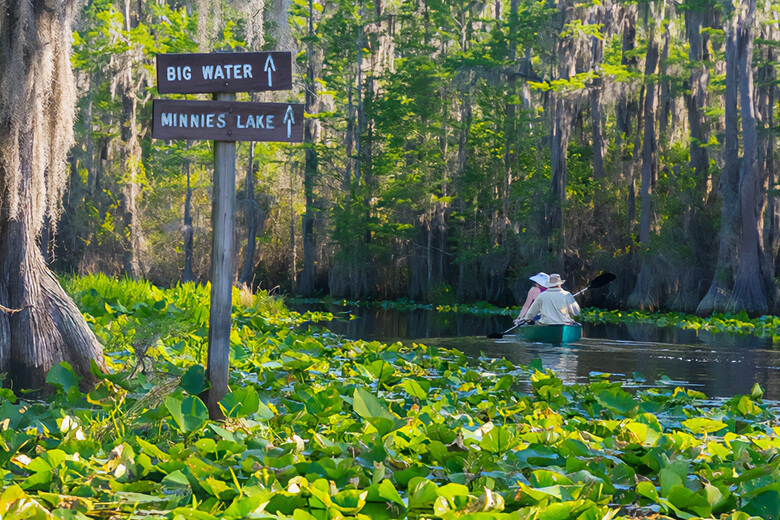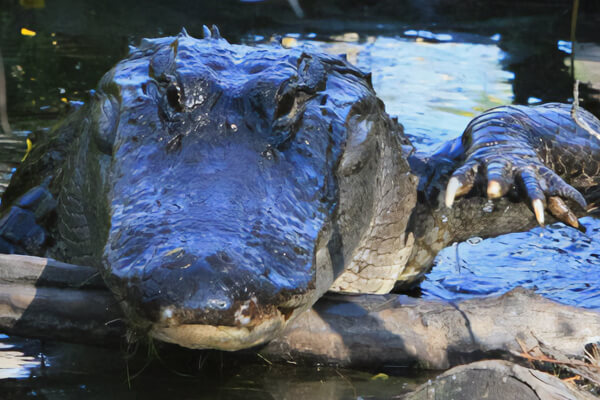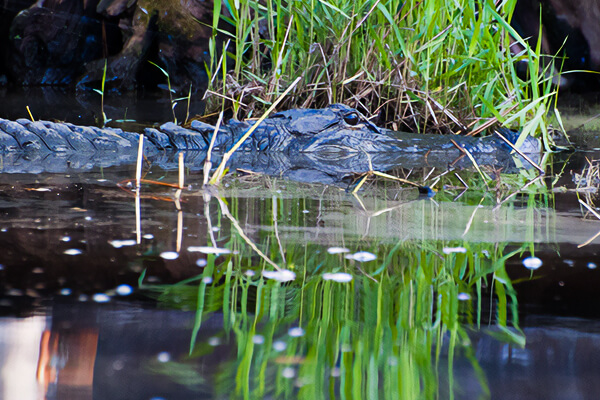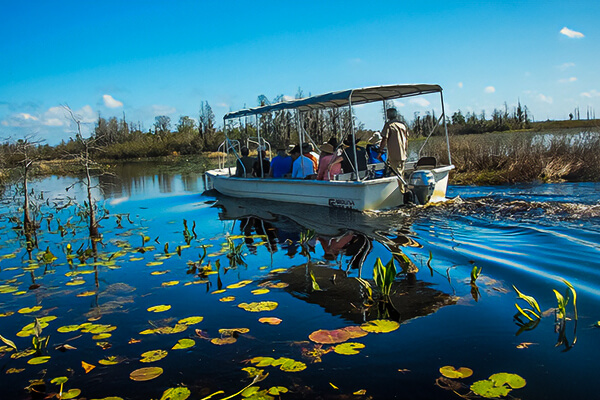
Beautifully preserving a piece of what America was like at its inception, the Okefenokee Wonderland is an essential part of America’s history. The Okefenokee Wetlands Park, within the Okefenokee National Wildlife Refuge, serves as both an accessible gateway to the refuge and a spectacular showcase for the refuge’s natural splendor.
In this vast expanse of islands, lakes, forests, woodland, and plains, the waterways reflect the majesty of the sky above and provide a path to any destination. The combination of canoe rides along historic Indian rivers, hiking trails through the forest, Pioneer Island, and the chance to see native animals in their natural environments creates an enchanting portrait of life in the early American frontier.
There are many things to see and do here, including the “Eye on Nature Wildlife Show,” a low-water walkway, a 90-foot Observation Tower, a Nature Center with a bee colony observatory, places to observe wildlife, the Walt Kelly Exhibit, and much more.
The Okefenokee National Wildlife Refuge was established in 1937 on 371,445 acres (150,319 ha) of primarily Georgian swampland. Its administrative center is located in Waycross. Due to its floating islands, the Seminole Indians likely named the area “trembling earth,” hence the name of the wetland.
Visit Okefenokee National Wildlife Refuge and experience the untamed side of existence. A biological miracle, this forest spans 680 square miles. Folkston, Georgia, about an hour’s drive from Jacksonville, Florida, is where most visitors to the National Wildlife Refuge will find the refuge’s primary entry.

The distinctive characteristics of the Okefenokee Wetlands are protected by the Okefenokee National Wildlife Refuge for the benefit of future generations. It is believed that the Suwannee and St. Marys Rivers both originate in this wetland. Wildlife of all kinds, including rare and critically imperiled species, rely on the food and shelter that habitats provide. Bio-indicators of worldwide health, such as amphibian populations, have earned international fame.
In general, the National Wildlife Refuge System exists to protect and preserve wildlife. Everything that happens on U.S. Fish and Wildlife Service-managed land and water within the Refuge System is governed by this policy, from the reasons a refuge is created to the leisure opportunities provided to the resource management techniques employed. To guarantee the continued existence of native wildlife populations, the Service’s Refuge System employs conservation best practices in the management of its lands and waterways.
What to do at Okefenokee National Wildlife Refuge?
Climb the Chesser Island Boardwalk towards the Owl’s Roost Tower for a unique perspective of the marsh grasslands and the Okefenokee Wilderness. Start your time in Okefenokee at the Richard S. Bolt Visitor Center, where you can learn about the park from refuge employees and volunteers, see interesting displays, and catch an introduction film in the theater.
Boat excursions, concessions, and canoe/kayak rentals are all available from Okefenokee Adventures, an onsite restaurant. Canoeing, paddling, wilderness camping, and photographing native animals are just some of the activities that can be enjoyed in the area.

The Enchanting Wilderness of Okefenokee Swamp
The Okefenokee Wetlands, the source of the Suwannee and St. Marys rivers, is protected in the Okefenokee National Wildlife Reserve. A broad array of animals, including rare and threatened species like the red-cockaded woodpecker, indigo snake, and wood stork, find safe haven in the refuge.
Indicators of worldwide health, the region’s amphibian numbers have garnered international attention. In refuge areas, scientists have documented the presence of over 600 different plant types. There are 353,981 acres of the National Wilderness Region contained within the Okefenokee National Wildlife Refuge.
The Okefenokee Swamp is so significant and valuable that the sanctuary is designated as a Wetland of International Importance by the Ramsar Agreement of 1971. As a result of its international importance, the Okefenokee National Nature Reserve is also on the shortlist for potential induction as a World Heritage Site.
The Okefenokee Swamp is a wildlife sanctuary and swamp located in southern Georgia and northern Florida in the United States. It’s a shallow, saucer-shaped hollow that’s more than 600 square miles in size and measures about 25 miles (40 km) broad and 40 miles (65 km) long (1,550 square km).
The low, sandy Trail Ridge on the east blocks direct draining into the Atlantic from the Okefenokee Swamp, which is located about 50 miles (80 km) upstream from the Atlantic shore. The Suwannee and St. Mary’s rivers help carry some water southeast into the Ocean from the marsh.
There are tiny islets (called hummocks) in the middle of marshes, low, sandy hills, damp, grassy savannas, and vast “prairies,” or dark water regions covered by undergrowth and trees, all within the Okefenokee Swamp.

Dense vegetation can be found in the marsh, with gigantic tupelo and bald cypress trees covered in Spanish moss, brush, and vines. Pine trees prevail on the sandy soil that lies above the water. Open water pathways wind together to create a complex labyrinth. Floating hearts, lilies, and unique orchids are just some of the exotic blooms that can be found here.
About 175 bird species and at least 40 species of animals, including raccoons, black bears, white-tailed deer, bobcats, foxes, and otters, call the wetland home. In addition to the crocodiles, alligators can be found here as well.
The wildlife in Okefenokee National Wildlife Refuge
Refugees and hatching grounds for migrating birds and other animals are among the stated goals of the Okefenokee National Wildlife Refuge. The area is home to numerous rare and vulnerable species, including red-cockaded woodpeckers, wood storks, and eastern indigo snakes.
The American alligator is the most well-known resident of Okefenokee National Wildlife Refuge. Visitors to the Okefenokee Swamp are almost certain to see at least a few of the essential and beautiful alligators that call the swamp home; the number of these animals is believed to be around 15,000.
The swallow-tailed kite, sandhill crane, Bachman’s sparrow, prothonotary warbler, red-shouldered hawk, and barred owl are some other noteworthy bird species living in the area. Gopher tortoise, timber rattlesnake, Florida softshell turtle, and a wide variety of watersnake species are some of the other reptiles that call this area home.

Okefenokee is famous for its rich biodiversity because of its location in the Southeast, the “cradle of biodiversity” in North America. More than 600 vegetation species, 40 mammal species, 50 reptile species, and 60 amphibian species call the wetland home.
The wetland is vital to the migration of many species, and scientists have found more than 200 different kinds of birds there. Its tea-colored water is home to 34 unique species of fish. The red-cockaded woodpecker, indigo snake, and wood stork are just a few of the federally protected species that make their home in the swamp.
Downriver on St. Marys and Suwannee Rivers, the swamp provides a safe haven for shortnose, Atlantic, and gulf sturgeon, all of which are also protected at the federal level.
Suwannee River and St. Marys river in Okefenokee National Wildlife Refuge
Blackwater in nature, the St. Marys River is both one of Georgia’s “endangered locations” (according to the Southern Environmental Law Center) and one of America’s “endangered rivers” (according to American Rivers).
From the western tip of Trail Ridge (the ancient relics of a barrier island system), it emerges as a tiny creek called “River Styx” and flows southeast into the Okefenokee Swamp. Just 50 miles after leaving its source, the river empties into the Atlantic Ocean near St. Marys, Georgia and Fernandina Beach, Florida, after a 125-mile journey down the river.

As a high-quality blackwater river, St. Marys has a pH that is already quite low. Tannin, a naturally occurring, water-soluble natural substance, is responsible for the “tea-hue” of the water, which is caused by decomposing plants.
The Suwannee, a legendary blackwater river that travels over 240 miles from South Georgia via North Florida to the Gulf of Mexico, also has its origins in the Okefenokee Swamp. The Suwannee River and its surrounding swamp are regional natural treasures made renowned for Stephen Foster’s songs. Because of its exceptional purity and the importance of the natural populations it supports, the state of Florida has named it an Outstanding Florida Water.
The Suwannee River Wilderness Trail connects the swamp’s network of canoe paths with the Gulf of Mexico, making the river a haven for outdoor enthusiasts in search of world-class canoeing, camping, and backcountry adventures. Nearly 300 crystal-clear, frigid streams feed into the Suwannee, making it one of the most prolific sources of freshwater in the United States.
Federally protected species such as the gulf sturgeon, the West Indian manatee, and freshwater mussels like the Suwannee moccasin shell and the oval pigtoe thrive in this diverse ecosystem of blackwater and blue holes springs.



